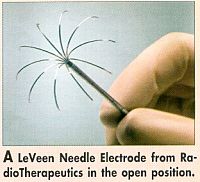RF Ablation System for Liver Lesions
SUNNYVALE, California-RadioTherapeutics Corporation has received clearance from the FDA to market its RF System for the ablation of nonresectable liver lesions. The system, consisting of the RF 2000 Radio-frequency Generator and family of LeVeen Needle Electrodes, provides radiofrequency (RF) energy to heat and destroy soft tissue.
SUNNYVALE, CaliforniaRadioTherapeutics Corporation has received clearance from the FDA to market its RF System for the ablation of nonresectable liver lesions. The system, consisting of the RF 2000 Radio-frequency Generator and family of LeVeen Needle Electrodes, provides radiofrequency (RF) energy to heat and destroy soft tissue.

In one multicenter clinical study of the RF System, more than 120 patients with unresectable liver tumors received RF ablation. Post-procedure complications were limited to 2.4% of patients, and the rate of tumor recurrence was less than 2% with a median follow-up of 15 months, the company said in a news release.
To perform the RF procedure, the physician uses ultrasound or CT imaging to guide a small LeVeen Needle Electrode directly into the target liver lesion. Once positioned inside the lesion, an array of wire tines in the shape of an umbrella (see Figure) penetrates a larger volume about the needle. Radiofrequency energy, provided by the RF 2000 generator, is then applied to coagulate and ablate the lesion by heating it to a lethal temperature.